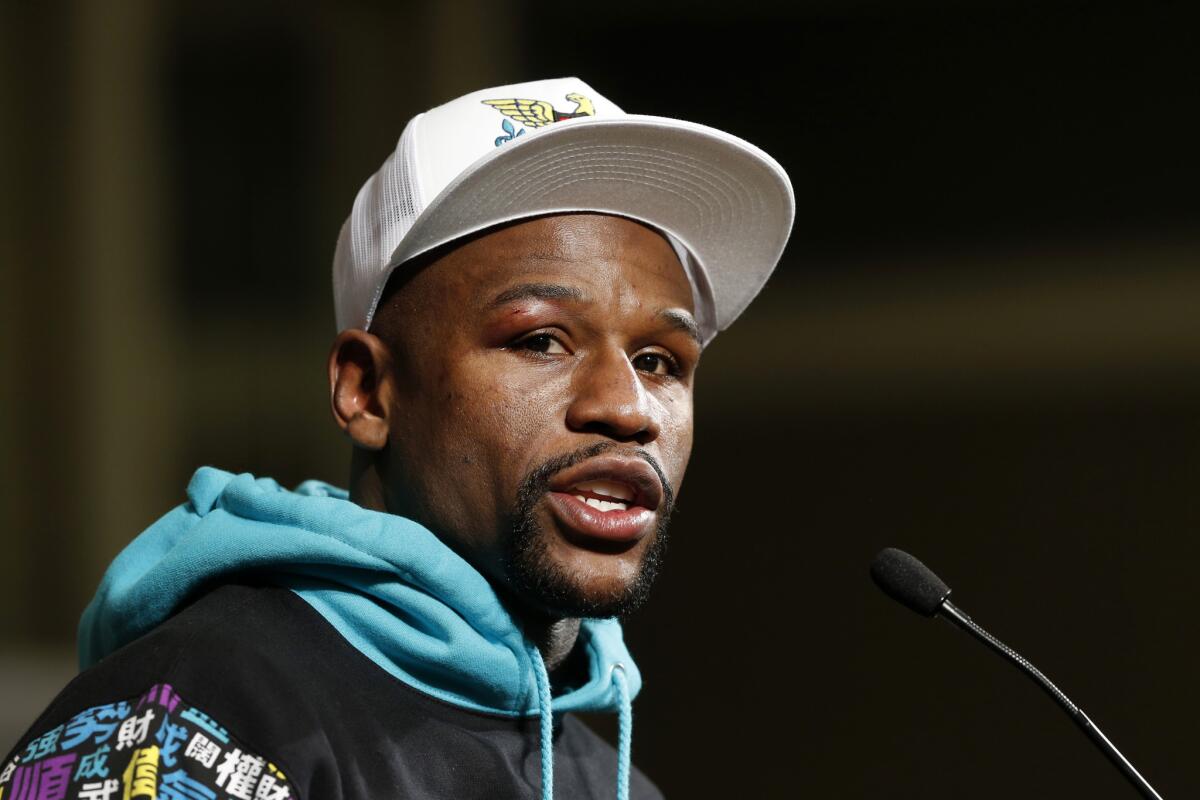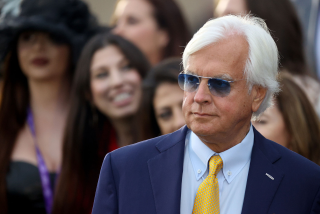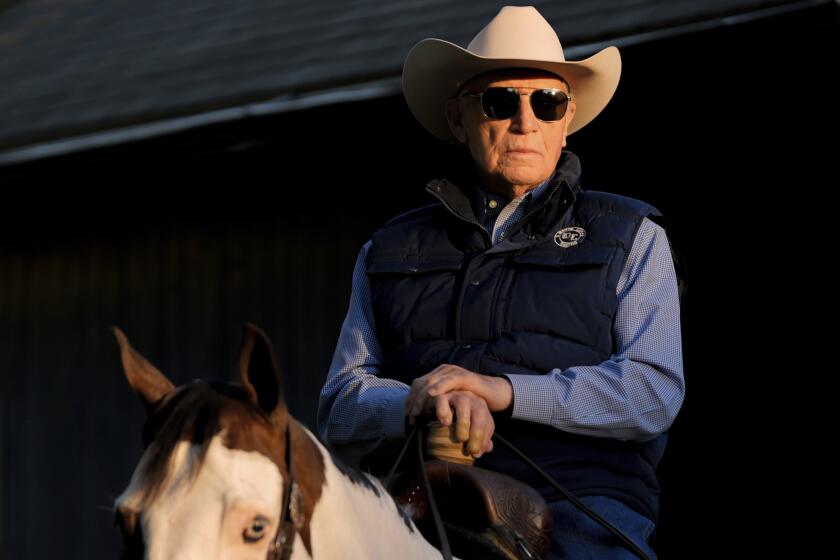USADA delivers rebuttal at writer who detailed Mayweather’s IV use

Floyd Mayweather Jr. speaks at a news conference after defeating Andre Berto on Sept. 12.
- Share via
After bringing down seven-time Tour de France winner Lance Armstrong by exposing his years-long doping scheme, the reputation of the U.S. Anti-Doping Agency was riding high.
Now, a week after award-winning boxing reporter Thomas Hauser took USADA to task over its work in the sport, the anti-doping agency is defending itself with an extended rebuttal that labels several of the reporter’s points as inaccurate or misleading.
“It’s unacceptable to put out information without properly fact-checking it,” USADA Chief Executive Travis Tygart told The Times in a telephone conversation Thursday night.
USADA has come under fire for operating too independently in its drug-testing work for Floyd Mayweather-Manny Pacquiao fight in Las Vegas in May.
Not only did the Nevada State Athletic Commission deny Pacquiao an injection of the anti-inflammatory medication Toradol before the fight, with commission members saying the USADA should’ve informed the commission of his interest in taking the pre-fight shot, Hauser reported that Mayweather was allowed a retroactive Therapeutic Use Exemption (TUE) for an IV treatment after weighing in for the bout.
The incidents led Bob Bennett, executive director of the Nevada commission, to tell The Times last week that USADA needs to improve its communication after it didn’t inform the commission or Pacquiao’s camp of Mayweather’s IV until days after the bout. Nevada will no longer recognize third-party test results in the state without those results being confirmed by a World Anti-Doping Agency lab in Utah.
Other turns in Hauser’s story hinted that Mayweather could have used the IV as a method to mask performance-enhancing drug use, questioning how some of his past samples have been eliminated by something called an “inadvertent use waiver” and detailing how the USADA produced a positive test of former champion Erik Morales in 2012 but failed to stop his fight.
USADA, indignant about the accusations that company sources say threaten to harm its brand and erode confidence among tested athletes, released a 25-page rebuttal to Hauser’s article on SB Nation.
Hauser is a 2004 winner of the Boxing Writers Assn. of America Nat Fleischer Award for excellence in boxing journalism. The noted author of books, including one on Muhammad Ali, he routinely collects BWAA prizes for his long-form reporting.
After a continued run of reporting on HBO about the sport’s inner workings, with several stories painting USADA in a negative light, Hauser was hired by the premium network as a paid consultant.
And with Mayweather poised to take the stage Saturday for a pay-per-view bout he said was his final fight, a unanimous-decision victory over Andre Berto on HBO’s rival network, Showtime, Hauser’s story went live just as the bout’s Sept. 9 news conference was starting.
His extended story revealed how USADA allowed Mayweather the IV treatment for dehydration following his May 1 weigh-in and proceeded to raise suspicions about the neutrality and effectiveness of the doping agency’s work under the headline, “Can Boxing Trust USADA?”
In response to the USADA corrections, Hauser wrote Thursday on boxingscene.com that “USADA has yet to explain the medical justification” for not treating Mayweather’s dehydration with “several glasses of water.”
Tygart, whose agency was retained this year by the Ultimate Fighting Championship to conduct year-round testing for athletes, alluded to what many see as axes to grind in the Hauser story.
“Apparently, there are a lot of people who are scared of the status quo changing in the sport of professional boxing, like it has in the UFC,” Tygart said. “Clean athletes, just like those in the UFC, deserve to have the best anti-doping plan in place, if possible.”
USADA officials say the funds they receive for testing boxers, including the six-figure fee they gained for Mayweather-Pacquiao, pales to the financial backing they receive from other entities, including its testing for the U.S. Olympic Committee.
One USADA supporter asked, “Why would we go after an American hero, a cancer survivor (Armstrong) and not go after Public Enemy No. 1?” a reference to Mayweather’s domestic violence history and boastful style that has made him a sporting villain.
Among the many disputes with Hauser’s story, USADA noted in its news release Wednesday that, “Under the [WADA] Code, if an athlete has a need to use a prohibited method or substance, they may apply for and be granted a TUE. Having an approved TUE means that the athlete is not in violation of the anti-doping rules.
“Contrary to Mr. Hauser’s inaccurate reports, [a USADA official] was in the home and observed Mr. Mayweather’s condition that precipitated the need for an IV. The [official] was also in the home when the paramedic was called and remained in the home while the paramedic provided the IV. At no point during the infusion did Mr. Mayweather attempt to hide anything regarding the treatment he was receiving.
“Mr. Mayweather’s use of the IV was not prohibited under the NSAC rules at that time and would not be a violation of the NSAC rules today.”
The USADA statement also claims “there is no such thing as an inadvertent use waiver … and USADA certainly did not invent such a process for the benefit of Mr. Mayweather.”
Hauser’s story, quoting former BALCO mastermind Victor Conte, also questioned USADA’s reluctance to incorporate Carbon Isotope Ratio testing to identify synthetic testosterone use.
“Contrary to Mr. Hauser’s unsubstantiated claims … CIR testing was conducted on all 22 urine samples collected from both Mr. Mayweather and Mr. Pacquiao during the testing program in advance of their fight,” according to the statement.
“USADA maintains, however, that focusing only on CIR testing is not up to current scientific practices. USADA also utilizes the Athlete Biological Passport to longitudinally monitor an athlete’s urine and blood profiles, which allows us to look for any minor or major fluctuations in an athlete’s blood and steroid values, including fluctuations in their [testosterone/epitestosterone] ratio.”
In Hauser’s Wednesday response, he asked about such fluctuations, seeking to know if USADA could publish those T/E ratio results from each sample Mayweather has provided USADA from his 2010 fight against Shane Mosley through the Berto bout.
As for Morales, USADA noted it sanctioned him for two years, calling Hauser’s reporting on that situation “purely outrageous and speculative.” Morales hasn’t fought since his loss to Danny Garcia was further tarnished by the positive result for clenbuterol.
“Mr. Hauser’s story is worse than mere shoddy journalism, it consists of numerous false allegations, unsupported by any facts and where the truth could have been verified through effort by Mr. Hauser,” according to the 33-point “USADA Corrections” report.
By determining there was “an agenda to smear us,” as one anti-doping official said, USADA said it foresaw “trade damage” without an extended response. At this point, there are no plans for a lawsuit.
One official, who is not authorized to speak publicly about active business negotiations, said USADA is currently in discussions with at least one boxing promotional company to enact year-round random testing.
Twitter: @latimespugmire
MORE IN SPORTS:
Brain disease CTE found in 87 of 91 NFL players tested, researchers say
At 40, Tito Ortiz is still after an MMA championship
High school players say coach told them to hit referee
More to Read
Go beyond the scoreboard
Get the latest on L.A.'s teams in the daily Sports Report newsletter.
You may occasionally receive promotional content from the Los Angeles Times.











